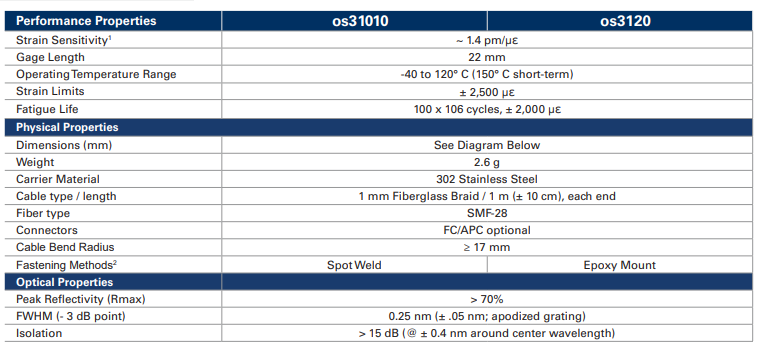The os3100 Optical Strain Gage is designed to make fiber handling easy and sensor installation fast and repeatable. Its stainless steel carrier holds the FBG in tension and protects the fiber during installation. Since there are no epoxies holding the fiber to the carrier, long term stability is ensured by design. For temperature compensation, the os3100 may be connected in series with an os4100, FBG Temperature Compensation Gage or an os4350, FBG Temperature Sensors.
Two mounting options provide for either weld or epoxy attachment to a structure’s surface. Installation time is just a few minutes with welded gages and can be used immediately after attachment. Epoxy gages typically cure in less than 24 hours at room temperature, similar to electronic foil strain gages.
In side by side comparisons with foil strain gages, the os3100 is equally sensitive and accurate, while providing for greater strain range and 100 times more fatigue life. The os3100 strain gage is qualified for use in harsh environments and delivers the many advantages inherent to all FBG based sensors. This sensor can be used alone or in series as a part of an FBG sensor array. Installation and cabling for such arrays is much less expensive and cumbersome than comparable electronic gage networks. Multiple optical strain gages can be arranged in close proximity at 0, 45 and 90 degrees for strain rosette measurements.
Key Features Fast, simple, repeatable installation with either weldable or epoxy mounted design.
Cable integrated with sensor package for fiber protection and strain relief.
Double ended design supports multiplexing of many sensors on one fiber.
Qualified to same rigorous standards used for comparable electronic gages.
Gage installation and protection achieved with same methods as conventional electronic gages.
Micron Optics’ patented micro opto-mechanical technology.
Included in ENLIGHT’s sensor templates - allows for quick and easy optical to mechanical conversions
ApplicationsStructures (bridges, dams, tunnels, mines, buildings, oil platforms)
Energy (wind turbines, oil wells, pipelines, nuclear reactors, generators)
Transportation (railways, trains, roadways, specialty vehicles, cranes)
Marine vessels (hull, deck, cargo containers)
Aerospace (airframes, composite structures, wind tunnels, static and dynamic tests).
Homeland security (perimeter intrusion, heat detection, security gate monitoring)
Properties

